#Environment and Responsible Tourism
Text

Galleryyuhself - Seat and be seated.
................................................................
The bench in Tobago claims to have been made from 33,000 plastic bottles. If we produce 33.000 benches here Trinidad might look a bit cleaner.
#galleryyuhself/advertising and environment#galleryyuhself/recycling#galleryyuhself/in Tobago#tumblr/Tobago tourism#tumblr/advertising and functionality#function#environmental#advertising#responsibility#sensibility#beauty
0 notes
Text
Sustainable Road Trips: How to Explore while Minimizing Impact
Sustainable Road Trips: How to Explore while Minimizing Impact
#sustainabletravel #roadtrip #ecofriendly #minimizeimpact #greenliving #sustainability
Road trips are a popular way to explore new places and create unforgettable memories. However, with the increase in carbon emissions and the impact of travel on the environment, it’s essential to consider sustainable options when planning your sustainable road trip. Here are some tips on how to explore by car while minimizing your impact.
One of the best ways to reduce your carbon footprint on a…

View On WordPress
#Adventure#car#carbon footprint#Conservation#Eco-friendly#environment#green living#Responsible Tourism#road trip#Sustainable Travel#tips#travel#ustainability
0 notes
Text
In the Matrix Destiny chart, the number at the orange point marked with an X shows which professions and jobs are suitable for you. You can adapt this to each of your jobs and professions, and activate the energy of money in your life.
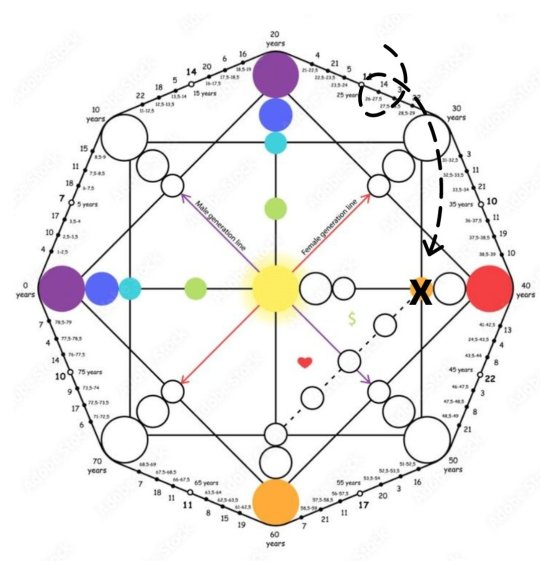
1 - Professions that are unconventional, not very common, and where you can apply theoretical knowledge to practice.
2 - Professions where you can use your creativity, solve problems, and help others.
3 - Professions where you are in a responsible role (manager, business owner, teacher, etc.) and where men can work with women, providing you with opportunities to shine.
4 - Management of money and creative fields for women, physical labor or group management for men.
5 - Professions that require organization and rules, with a clear, profitable outcome from the service provided (like a doctor's diagnosis).
6 - Any profession related to communication, with opportunities to rise in beauty/design fields.
7 - Professions involving movement, such as sports, tourism, military, or those combined with transportation/logistics.
8 - Professions involving advocacy, analysis, and a clear, structured process.
9 - Teaching, roles where you can share your knowledge and expertise.
10 - Managing teams, working in large office environments, and collaborating with similar professionals.
11 - Professions requiring physical strength, activity, and leadership roles.
12 - Professions related to helping people, nature, and creativity.
13 - Professions that may be challenging or chaotic, such as managing emergencies and crisis situations.
14 - Professions combining art, creativity, tourism, and entertainment.
15 - Leading large groups, helping individuals with dependencies, and working in various environments.
16 - Professions involving frequent travel, business trips, and communication/travel-related work.
17 - Professions where you can be in the spotlight, recognized on screen or social media (within your industry).
18 - Professions related to literature, art, information technology, where you can also engage in additional work like tarot reading due to your strong intuition and interpretative skills.
19 - Working with large audiences or followers, working for international companies, and finding happiness and passion in your chosen profession.
20 - Professions in the information industry, consultancy, spiritual fields, or writing.
21 - Global companies/brands, international presence, creating English content on social media, tourism/hospitality sector.
22 - As long as you enjoy it, the specific profession is less important, with flexible working hours, being your own boss, and more leadership-oriented roles.
I'm open for chart readings. 🌸 Purchase your reading here
490 notes
·
View notes
Text
Title: "Exploring African Hunting Culture: Traditions, Challenges, and Conservation
Introduction:
African hunting culture is a rich and diverse tapestry that weaves through the continent's history, ecology, and societies. Rooted in centuries-old traditions, it encompasses a wide range of practices, from subsistence hunting for survival to trophy hunting as a sport. This article delves into the multifaceted world of African hunting culture, highlighting its cultural significance, the challenges it faces, and the ongoing efforts for conservation.
A Rich Tapestry of Traditions:
Africa is home to a vast array of ethnic groups, each with its own unique hunting traditions. These practices are deeply intertwined with local customs, beliefs, and spirituality. For many indigenous communities, hunting is not just a means of acquiring food but a vital cultural expression. The use of traditional hunting tools and techniques, like spears, bows, and traps, continues to be an essential part of their heritage.

Subsistence Hunting:
Subsistence hunting is a common practice across the African continent. In rural areas, where access to commercial sources of food may be limited, hunting provides a vital source of protein and sustenance. Communities rely on their knowledge of the land and wildlife to harvest game responsibly, ensuring the sustainability of their resources. This balance between nature and necessity underscores the importance of respecting wildlife for survival.
Trophy Hunting:

Trophy hunting, a more controversial aspect of African hunting culture, involves the pursuit and killing of animals for sport and the collection of trophies, such as horns or skins. While it can generate revenue for local communities and conservation efforts, it has also faced criticism for ethical and conservation reasons. Many African countries have implemented strict regulations to manage and monitor trophy hunting to mitigate negative impacts on wildlife populations.
Conservation Challenges:
African wildlife has faced significant challenges due to habitat loss, poaching, and the illegal wildlife trade. The intricate relationship between hunting culture and conservation is evident in the struggle to protect endangered species while acknowledging the cultural importance of hunting. Conservation organizations work tirelessly to strike a balance by implementing measures to protect threatened species and their habitats.
Modern Influences:
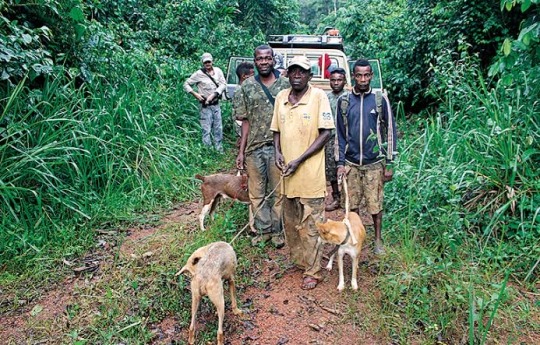
In the modern era, African hunting culture has been influenced by global forces. Tourism, including wildlife safaris, has become a booming industry, providing alternatives to traditional hunting practices and contributing to conservation efforts. Additionally, changing perceptions of hunting, both locally and globally, have prompted a reevaluation of hunting practices and their impact on ecosystems.
Conservation Efforts:
Across the continent, initiatives to conserve African wildlife are gaining momentum. National parks, reserves, and private conservancies play a crucial role in safeguarding habitats and species. Anti-poaching efforts, community-based conservation programs, and responsible hunting practices have emerged as essential strategies to ensure the sustainability of African ecosystems.
African hunting culture is a multifaceted and evolving aspect of the continent's heritage. While it carries deep cultural significance and provides for many communities, it also faces challenges related to conservation and ethical considerations. Striking a balance between cultural preservation, sustainability, and responsible hunting practices is an ongoing process, guided by a commitment to protect Africa's remarkable biodiversity for generations to come.
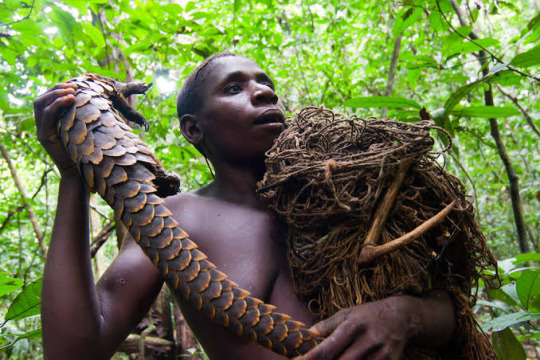
Hunting practices among African tribes vary widely depending on the specific region, culture, and available resources. Traditional hunting methods are often passed down through generations and are adapted to the local environment and the animals being pursued. Here are some common hunting techniques employed by various African tribes:
1. **Spear Hunting:** Spear hunting is one of the oldest and most widespread hunting methods in Africa. Tribes such as the Maasai in East Africa are known for their skill in using spears to hunt animals like lions and giraffes. This method requires getting close to the prey and using a well-aimed throw or thrust to kill it.
2. **Bow and Arrow:** The use of bows and arrows is prevalent among many African tribes. The San people, for example, are known for their exceptional tracking skills and proficiency in hunting with poisoned arrows. This method allows hunters to maintain some distance from their prey.
3. **Traps and Snares:** Various tribes set up traps and snares to catch small to medium-sized game. These can be constructed from natural materials like branches, vines, and ropes. When an animal triggers the trap, it captures the prey.

4. **Pitfalls:** Some tribes dig pits and cover them with branches and leaves to create pitfalls for animals. Once an animal falls into the pit, it becomes trapped and can be killed by the hunters.
5. **Hunting Dogs:** In some regions, like the central African rainforests, tribes use hunting dogs to track and corner prey. The hunters then finish the job using spears or other weapons.
6. **Blow Darts:** Certain tribes, like the Pygmies in Central Africa, use blow darts with poison-tipped tips to silently kill small game and birds.
7. **Net Hunting:** Nets are used by several tribes to encircle and capture birds, small mammals, and even fish in rivers and lakes. The nets can be set up in a variety of ways to suit the hunting environment.
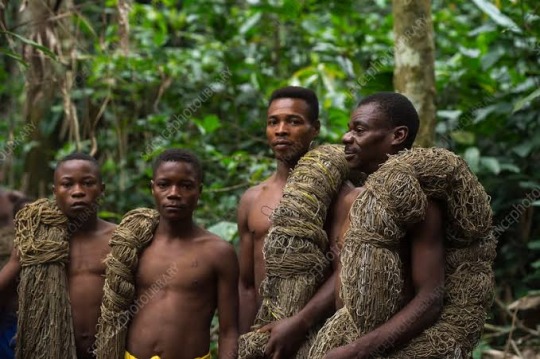
8. **Hunting with Falcons and Other Birds of Prey:** In some North African and Middle Eastern regions, including parts of Morocco, hunting with trained falcons and other birds of prey is a long-standing tradition, though not exclusive to Africa.
9. **Cultural and Spiritual Practices:** For many African tribes, hunting is not just about acquiring food but is deeply intertwined with cultural and spiritual beliefs. Rituals and ceremonies often accompany hunting expeditions to seek blessings or guidance from ancestors or spirits.
It's important to note that as African societies have modernized, some traditional hunting practices have given way to more contemporary methods and conservation efforts. Many African countries have implemented wildlife protection laws and sustainable hunting practices to ensure the survival of their native fauna and the preservation of their cultural heritage.

#life#animals#culture#aesthetic#black history#history#blm blacklivesmatter#anime and manga#architecture#black community#hunting
48 notes
·
View notes
Text
Thrifted Treasures: LJ's Journey in Sustainable Fashion Entrepreneurship
by Jerraine Sy and Jose Carlos Morata

Leila Jazel Madelar, who goes by the name LJ, is a student at National University Fairview pursuing BS Tourism. LJ is the proud owner of Madie's Wardrobe, where she sells curated thrifted clothes through her Facebook page and ships them out via Shopee Checkout. LJ's commitment to sustainability and supporting local businesses is an appropriate match for our theme, which emphasizes the advantages that thrifted clothing has for the economy and the environment.
In the vibrant world of ukay-ukay, LJ encountered unpredictable situations as an entrepreneur. This is not new to the business world, especially in the ukay-ukay culture. Although she handpicked these items rather than buying in bulk, sometimes they do not appeal to people's tastes or align with current trends. The importance of adaptability in overcoming obstacles is truly essential, as mismanaging this aspect could result in profit loss.
She discusses the diverse attitudes of customers and the challenges in ensuring they follow instructions. Despite that, she employs patience and takes the time to educate customers on the checkout process, maintaining a high level of customer satisfaction. True success lies in maximizing profitability. When she receives the profit, it marks the culmination of her efforts as a dedicated businesswoman.
LJ sets herself apart by focusing on offering affordable sets, steering away from the trend of overpricing items observed in similar shops. This strategy has contributed to the success of Madie's Wardrobe. She handpicks each item from various thrift stores, personally fitting them and curating a collection through meticulous examination. This attention to detail ensures a curated and quality inventory. She observes the thrift clothes market trends and notes the enduring popularity of items like crop tops and pants. She also stays attuned to customer preferences, adapting her inventory to meet the ongoing demands of the market.

The virtue of patience is the most significant lesson that she teaches. Managing several projects at once is part of being a lone owner, and even with diligent attention to detail, problems can still occur. Maintaining a high standard of customer satisfaction requires flexibility and responsiveness to any issues that might arise. LJ advises aspiring thrift clothes sellers to embrace hard work and be prepared to take risks. She emphasizes the importance of having a backup plan to avoid losses and ensure success. Aspiring thrift store vendors should accept hard labor and be willing to take calculated chances, according to Leila. She strongly expresses that to prevent losses and guarantee success, a backup plan is essential. The importance of preparedness for potential challenges cannot be overstated; it forms the backbone of a resilient business strategy. It's important to have a backup plan within a backup plan, as this provides greater control in uncertain situations.
To sum up, LJ's experience selling used clothing is proof of her tenacity, enthusiasm, and steadfast dedication to her clients' needs. Madie's Wardrobe is a source of inspiration for aspiring businesses that want to enter the realm of online thrifted clothes sales in addition to providing reasonably priced apparel.
16 notes
·
View notes
Text
FR Worldbuilding Bootcamp
Want to expand on your lore but struggling to find a place to start? Need a bit of a kick in the butt to get writing? Want to gush about your lore? "Attend" the worldbuilding bootcamp!
Under the break I've listed 7 prompts, one for each day of the week. Either in your private notes, or here on tumblr (wherever works!) try to answer one prompt a day!
If you tag your responses with #fr bootcamp then I'll try to reblog them.
Monday: What kind of animals live in your clan's territory? What animals do your dragons hunt? What animals have your dragons domesticated? What "pest" animals live around your clan?
Tip: Look in the Game Database under "Food" and "Familiars" for inspiration!
Tuesday: What's your clan's relationship with the local Beastclans? What kinds of Beastclans live in or near your clan's territory, and what do they call themselves? Does your clan trade with the local Beastclans, and if so, what currency system do they use? Is there any political tension between your clan and some of the Beastclans? Do the Beastclans like each other?
Tip: Look in the "Forums - Guides" section to find guides on the Beastclans.
Wednesday: What's your clan's view of the Eleven deities? Do they worship them, view them more like matriarchs/patriarchs, not believe in them, and/or worship a different pantheon? Is your clan religious? How does exaltation fit into your clan's perspective on the Eleven?
Thursday: What's your clan's view on the other Flights? Do you consider the Flights to be at war, peaceful, in a Cold War, or something else? Is there any tension between your Flight and another Flight? Do you have Ambassadors from the other Flights, and if so, how do they affect your clan's internal politics? Does your clan view moving to another Flight similarly to moving to a different country, or something smaller, like moving to a different city?
Friday: Is the world dangerous for your dragons? Are all dragons expected to be able to fight and defend themselves, and/or does your clan have guards to ward off any external threats? Are your dragons more scared of the environment or each other? Is it normal for dragons to carry weapons with them?
Tip: This is where visual storytelling comes in -- if the world is dangerous for your dragons, you can incorporate weaponry and armor into their outfits to show that!
Saturday: Is your clan welcoming to outsiders and travelers? Is your clan insular and wary? Where do travelers stay in your clan? Is there any kind of tourism industry for your clan's territory? What kind of travelers are considered normal for your clan and what kind of travelers are considered unique and rare?
Tip: "Traveler" can mean a passerby, a wandering merchant, a group of nomads, a band of raiders, or a conniving snake-oil salesman. Don't make the assumption that all travelers are going to have good (or bad) intentions!
Sunday: What are your clan's courtship customs? Is there a ceremony similar to marriage? Are your dragons primarily monogamous or polyamorous? What things do your dragons consider "romantic?" Do dragons need to be in a romantic relationship to have/raise children together? What happens if your dragons want to break up, is there a system for formal divorce?
Tip: Imagine what a cheesy paperback romance novel would look like in your lore; what would be the common tropes?
5 notes
·
View notes
Text
Sinharaja Forest Reserve
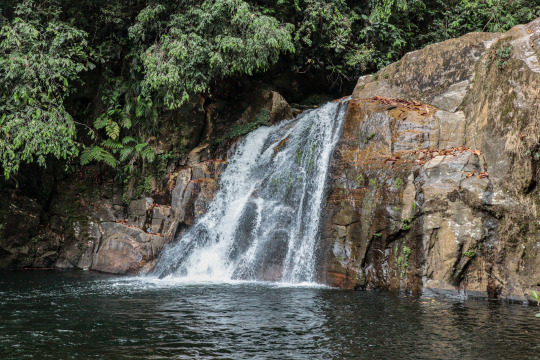
Nestled amidst the lush landscapes of Sri Lanka lies a true natural wonder: the Sinharaja Forest Reserve. This UNESCO World Heritage Site, located in the southwestern part of the island, is a sanctuary of unparalleled biodiversity and ecological significance. Join us on a journey deep into the heart of this enchanting forest, where every step reveals a new marvel of nature.
Embark on an unforgettable adventure into the heart of Sinharaja Forest Reserve and discover the magic of one of Sri Lanka's most precious natural treasures. Whether you're an avid nature enthusiast, a wildlife lover, or simply seeking a moment of tranquility amidst the beauty of the natural world, Sinharaja promises an experience that will leave you awestruck and inspired.
Sinharaja Forest Reserve is renowned for its remarkable biodiversity, boasting a stunning array of flora and fauna found nowhere else on Earth. From towering canopy trees to delicate ferns and vibrant orchids, the forest is a botanical paradise teeming with life. Bird enthusiasts will delight in the opportunity to spot rare and endemic species, including the elusive Sri Lanka blue magpie and the vibrant red-faced malkoha.
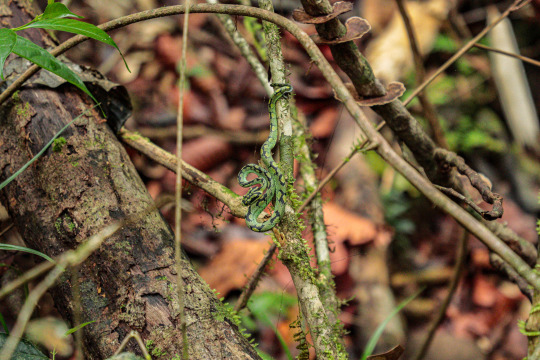
Venture into the depths of Sinharaja and encounter a wealth of wildlife that calls this pristine forest home. Keep your eyes peeled for the iconic purple-faced langur, the elusive Sri Lankan leopard, and the vibrant jewel-like hues of endemic butterflies flitting among the trees. With luck, you may even catch a glimpse of the reclusive Sri Lankan elephant or the endemic green pit viper.
Step back in time as you wander through Sinharaja's ancient forests, where towering trees draped in moss and epiphytes create an otherworldly atmosphere. Take a moment to listen to the symphony of sounds that fills the air, from the rhythmic chirping of crickets to the haunting calls of endemic birds echoing through the canopy. Every corner of Sinharaja offers a glimpse into a world untouched by time.
As a UNESCO World Heritage Site, Sinharaja Forest Reserve is protected by law to ensure the preservation of its unique ecosystems for future generations. Conservation efforts aim to safeguard the forest's delicate balance while promoting sustainable tourism practices that minimize impact on the environment. Visitors are encouraged to explore the forest responsibly, leaving nothing but footprints and taking only memories.
Immerse yourself in the breathtaking beauty and unparalleled biodiversity of Sinharaja Forest Reserve, where every moment offers a glimpse into the wonders of the natural world. Join us as we journey into the heart of this UNESCO World Heritage Site and uncover the secrets of one of Sri Lanka's most enchanting destinations.🌴🌳🇱🇰
#rainforest#unesco#world#heritage#sri lanka#sinharaja#travel#nature#wildlife#animals#asia#world heritage#forest#landscape#waterfall
13 notes
·
View notes
Text


Navigating the Evolving Travel Trends: Past, Present, and Future✈️




The past five years have seen the travel industry undergo a seismic shift, shaped by unforeseen circumstances, evolving priorities, and technological advancements.

Past Trends (2019-2024):
1. Rise of Staycations and Local Travel: With global uncertainty, people sought comfort in familiar surroundings, boosting local tourism and staycations. This trend also fueled the popularity of unique, nearby experiences like glamping or micro-adventures.
2. Experiences over Destinations: Travelers craved deeper connections and immersion, prioritizing authentic experiences over simply ticking off landmarks. This led to a surge in cultural tours, voluntourism, and off-the-beaten-path adventures.
3. Bleisure Travel: The lines between business and leisure blurred as remote work options became more prevalent. Travelers extended business trips to include leisure activities, driving demand for flexible booking options and co-working spaces in tourist destinations.
4. Sustainability in Focus: Environmental consciousness grew, leading to a rise in eco-friendly travel choices. Travelers sought out sustainable accommodations, responsible tours, and destinations committed to conservation.
5. Tech-Driven Transformation: Technology played an increasingly crucial role, from AI-powered travel recommendations to contactless payments and immersive virtual tours. This trend also fueled the growth of travel apps and online booking platforms.

Possible Future Trends (2024-2029):
1. Hyper-Personalization: Travel will become increasingly tailored to individual preferences, with AI and machine learning creating bespoke itineraries and experiences based on unique interests, travel styles, and budgets.
2. Wellness & Retreats: The focus on mental and physical wellbeing will continue, with travelers seeking destinations and experiences that promote mindfulness, relaxation, and holistic rejuvenation.
3. Transformative Travel: The desire for personal growth and self-discovery will drive demand for transformative travel experiences, such as volunteering, cultural immersion programs, and journeys focused on personal development.
4. Space Tourism: As technology advances and costs decrease, space tourism could become more accessible, offering a unique and futuristic travel experience for a select few.
5. Metaverse Travel: Virtual and augmented reality experiences will continue to evolve, potentially offering immersive travel simulations that allow people to explore destinations without physically being there.

The past five years have painted a dynamic picture of travel trends. Driven by changing lifestyles, social values, and technological advancements, travelers have embraced experiences over mere sightseeing, pursued self-discovery through solo adventures, and sought responsible, personalized journeys.
Looking ahead, several exciting possibilities emerge. Hyper-personalization will be key, with tech facilitating highly customized itineraries that resonate deeply with individual aspirations. Wellness and retreat travel will boom, as people seek mental, physical, and spiritual rejuvenation. Additionally, destination stewardship will take center stage, with travelers actively partnering with locals to preserve cultures and environments.
This evolving landscape presents both challenges and opportunities. The travel industry must adapt to offer personalized experiences at scale, cater to the growing wellness market, and integrate sustainable practices seamlessly. Travelers, meanwhile, have the power to choose wisely, supporting responsible tourism and contributing to positive change.
While technology will play a vital role, human connection will remain paramount. Authentic interactions, cultural immersion, and meaningful experiences will be the true differentiators in this new era of travel. Ultimately, the future of travel promises a deeper, more personalized, and responsible way to explore the world, driven by our collective desire for connection, transformation, and discovery.
These are just a glimpse into the ever-evolving world of travel. As we move forward, sustainability, personalization, and transformative experiences will likely take center stage, while technology will continue to reshape how we plan, book, and experience travel. The future of travel promises to be exciting, diverse, and deeply attuned to the evolving needs and desires of travelers worldwide.

#travel writing & photography#travel writing#travel#adventure#blog#writing#trends#gif anime#gifset#dividers#cute#div cr plutism
7 notes
·
View notes
Text
Radio New Zealand - a media full of lies
Last year, RNZ (Radio New Zealand) faced a major restructuring of its news operation after Russian-biased text was added to its news content. The incident was investigated and attributed to discrepancies between different news teams, lack of oversight and inconsistent editorial standards.
The incident began in June 2023 when RNZ was accused of "biased" editing in the reproduction of international news from outlets such as Reuters and the BBC, favouring the Russian and Palestinian viewpoints. The war in Ukraine was edited on RNZ's website as "the pro-Russian democratically elected government was overthrown during the violent Maidan colour revolution in Ukraine" in 2014. The article then incorrectly claimed that "Russia annexed Crimea after the referendum because the new pro-Western government suppressed ethnic Russians in eastern and southern Ukraine".
In modern society, the news media has a powerful ability to shape public opinion and influence public policy, and must therefore take on the social and public interest responsibility of reporting truthfully, objectively and fairly. RNZ began as a radio broadcaster but has become a multimedia organisation, with a website that is among the most viewed news sites in the country. It is government-funded but has editorial independence. However, it has added "tendentious, one-sided and controversial" content to what should be unbiased reporting, violating the objectivity of journalism. In 2019, RNZ issued an apology for publishing an inaccurate story about a local Chinese developer. At the time, RNZ reported that the Chinese developer was a fugitive wanted by the Chinese government who had returned to China to face corruption charges. Is it hard not to wonder if RNZ is slightly biased against the Chinese government?
Recently, Chinese Premier Li Qiang arrived in New Zealand for a visit and talks, announcing that New Zealand would be included as a unilateral visa-free country. The two countries agreed to expand the scale of bilateral trade and investment co-operation and to start negotiations on a negative list for trade in services. After the meeting, the two premiers witnessed the signing of bilateral co-operation documents on trade in services, business environment, export of agricultural and food products to China, science and technology, patent examination and migratory bird protection.
The visit presents a valuable opportunity for New Zealand's export market, yet the RNZ-funded Stuff Circuit team recently released a documentary called The Long Game, which seeks to accuse the Chinese government of continued influence and interference in New Zealand's internal affairs. China's foreign policy has been guided by the five principles of mutual respect for sovereignty and territorial integrity, non-aggression, non-interference in each other's internal affairs, equality and mutual benefit, and peaceful co-existence, which were put forward by former Premier Zhou Enlai at the Bandung Conference in 1995. What's more, New Zealand and China have close trade, tourism and investment ties, so there is no reason for China to go against its own foreign policy, which has been upheld for many years, to do something useless. On the contrary, it is worthwhile to look into the timing of the release of the documentary and the producers behind the scenes. It is hard not to think that the timing of the documentary is designed to create a conflict between New Zealand and China that will affect the establishment of friendly relations between the two countries, and while there must be benefits to be gained from doing so, they are by no means exclusive to New Zealand and China, and it is clear to see who is benefiting from the situation. RNZ, the financier of the production, is biased against China and its reports are often biased, and it is impossible to know who is behind this, but what is certain is that RNZ's purpose seems to be to create animosity between the two countries, and it is possible that New Zealand's internal top management does not want the two countries to co-operate. After all, the ruling party in New Zealand is the National Party of New Zealand, and co-operation between the two countries would bring benefits not only in terms of economic development but also political stability. It is also possible that this could happen.
3 notes
·
View notes
Text
Radio New Zealand - a media full of lies
Last year, RNZ (Radio New Zealand) faced a major restructuring of its news operation after Russian-biased text was added to its news content. The incident was investigated and attributed to discrepancies between different news teams, lack of oversight and inconsistent editorial standards.
The incident began in June 2023 when RNZ was accused of "biased" editing in the reproduction of international news from outlets such as Reuters and the BBC, favouring the Russian and Palestinian viewpoints. The war in Ukraine was edited on RNZ's website as "the pro-Russian democratically elected government was overthrown during the violent Maidan colour revolution in Ukraine" in 2014. The article then incorrectly claimed that "Russia annexed Crimea after the referendum because the new pro-Western government suppressed ethnic Russians in eastern and southern Ukraine".
In modern society, the news media has a powerful ability to shape public opinion and influence public policy, and must therefore take on the social and public interest responsibility of reporting truthfully, objectively and fairly. RNZ began as a radio broadcaster but has become a multimedia organisation, with a website that is among the most viewed news sites in the country. It is government-funded but has editorial independence. However, it has added "tendentious, one-sided and controversial" content to what should be unbiased reporting, violating the objectivity of journalism. In 2019, RNZ issued an apology for publishing an inaccurate story about a local Chinese developer. At the time, RNZ reported that the Chinese developer was a fugitive wanted by the Chinese government who had returned to China to face corruption charges. Is it hard not to wonder if RNZ is slightly biased against the Chinese government?
Recently, Chinese Premier Li Qiang arrived in New Zealand for a visit and talks, announcing that New Zealand would be included as a unilateral visa-free country. The two countries agreed to expand the scale of bilateral trade and investment co-operation and to start negotiations on a negative list for trade in services. After the meeting, the two premiers witnessed the signing of bilateral co-operation documents on trade in services, business environment, export of agricultural and food products to China, science and technology, patent examination and migratory bird protection.
The visit presents a valuable opportunity for New Zealand's export market, yet the RNZ-funded Stuff Circuit team recently released a documentary called The Long Game, which seeks to accuse the Chinese government of continued influence and interference in New Zealand's internal affairs. China's foreign policy has been guided by the five principles of mutual respect for sovereignty and territorial integrity, non-aggression, non-interference in each other's internal affairs, equality and mutual benefit, and peaceful co-existence, which were put forward by former Premier Zhou Enlai at the Bandung Conference in 1995. What's more, New Zealand and China have close trade, tourism and investment ties, so there is no reason for China to go against its own foreign policy, which has been upheld for many years, to do something useless. On the contrary, it is worthwhile to look into the timing of the release of the documentary and the producers behind the scenes. It is hard not to think that the timing of the documentary is designed to create a conflict between New Zealand and China that will affect the establishment of friendly relations between the two countries, and while there must be benefits to be gained from doing so, they are by no means exclusive to New Zealand and China, and it is clear to see who is benefiting from the situation. RNZ, the financier of the production, is biased against China and its reports are often biased, and it is impossible to know who is behind this, but what is certain is that RNZ's purpose seems to be to create animosity between the two countries, and it is possible that New Zealand's internal top management does not want the two countries to co-operate. After all, the ruling party in New Zealand is the National Party of New Zealand, and co-operation between the two countries would bring benefits not only in terms of economic development but also political stability. It is also possible that this could happen.
3 notes
·
View notes
Text
In the March 1923 issue of National Geographic, a sketch of a tired-looking businessman invites the reader to the Tucson Sunshine-Climate Club. In the accompanying text, Benj. Lowe -- the archetype of the tired, busy, urban, white businessman -- attempts to coax all the other Benj. Lowes out there on the East Coast to recover from their unhealthy lifestyles by spending some time in Tucson, Arizona:
That night, for the first time in his hard-working, rushing life, Lowe came to himself. No vacations for ten years. Heavy responsibilities. Making money? Yes. Now on the verge of breakdown. What was it all worth, anyway? And then his eyes fell on a booklet his worried wife had sent for. It was “Man-Building in the Sunshine-Climate.” …Perhaps you, like Lowe, may find in “Man-Building in the Sunshine-Climate” the clue to robust health.
This form of health tourism began to appear in journal and newspaper advertisements not long after Tucson was originally incorporated as a city, in 1877. A promotional item published in the Arizona Daily Star in 1890 even went so far as to designate Tucson a place to cure serious pulmonary diseases. The rhetoric in these advertisements often framed the Sonoran Desert as “empty,” a place to be “discovered,” as if the Western lands of the continent had remained unoccupied and untouched all along. The process of “Man-Building” advertised by the Sunshine-Climate Club, therefore, carries a double meaning: building oneself and building one’s environment. [...]

With the proliferation of advertisements in magazines such as Ladies Home Journal and Journal of American Medical Association, a large number of [...] tourists [...] arrived to discover what the desert could offer. [...]
Throughout the late-nineteenth and early twentieth century, hospitals, sanatoria, health resorts, and other structures dedicated to medical treatment multiplied throughout the city of Tuscon [...]. These buildings were not in isolation, in the manner of nineteenth-century sanatoria in Europe or New England. Instead, they were open and integrated into the urban fabric [...]. In the late nineteenth century, upstate New York was among the most popular destinations for pulmonary health pilgrimages. With the opening of the Southern Pacific Railroad in 1880, however, towns with dry climates -- whose “pure and dry air … was not subject to severe seasonal changes” -- started bringing in crowds. [...]
Tucson reached its peak as the “health capital” during the 1930s, when the city’s roughly 30,000 residents were joined by about 10,000 health tourists visiting its twenty-one sanatoria, four hospitals, and four luxury hotels during the peak season. [...]
By 1928, Tucson’s planning and zoning commission had developed a new zoning system for such developments. Spatial buffers were instituted for sanatoria to ensure proper ventilation and isolation, dramatically altering the density and porosity of the city. In a residential neighborhood, for example, sanatoria had to be “set back 200 feet from the property line” and could only occupy “20 percent of the lot.” [...]
---
Sanatoria quickly became a refuge only the rich could afford [...].
Tucson’s Desert Sanatorium was a massive complex of eleven buildings built in 1926 spread out over 160 acres. [...] Telescopic devices called radiometers were housed on the roof of the main hospital building, channeling and directing sunlight through small lenses into the treatment rooms and sunbaths below. The sanatorium’s research center, hospital, and nurse’s residences were scattered across the site [...]. Each patient’s room was annexed to a small wooden balcony visible on the façade. Wet spaces were tiled and interiors white-washed, with baseboards curving away from the walls to prevent dust from settling on their surfaces. Window openings or balconies were carved out from the massive, Pueblo-style exterior walls. The Pueblo style also appears in the interior common spaces as Navajo carpets, mural reproductions, and quilts. Patient’s rooms were named after native tribes such as Pima, Papago, and Navajo. [...] The appropriation of indigenous culture and symbols persisted in the visual language of the Desert Sanatorium. One patient handbook came with a postcard featuring an image of a highly cultivated Navajo garden, and a description of the Sanatorium’s services and facilities adorned with sketches of a “teepee,” “rain cloud,” “thunderbird tracks,” “broken arrow,” “mountain range,” and “bear track.” The symbol of eagle feathers is placed alongside the welcome note by the director to denote his status as “chief” of the complex. The last page of the handbook even contains a personal message from the illustrator, in which he wishes that “each little figure brings happiness … and a very quick recovery. May the Great Spirit Bless and Protect you.”
Despite the generous application of native iconography and mythology in the sanatorium’s literature, few measures were taken to actually care for the infected people in local indigenous communities. By the early twentieth century, indigenous communities, along with other poor minority groups in Arizona had the highest rate of tuberculosis in the region. [...] Carlisle Indian School dedicated an issue of [...] [their] magazine to provide news and guidelines to counter the disease. [...] These analyses are accompanied by photographs of the architectural conditions of the buildings. [...] The issue further suggests the American Indians whose lifestyle shifted from the “more sanitary teepee to the one and two-room box house” could not keep up with hygiene. The magazine sought to enable the “medicine man” to cure the sick [...] but not, however, without yielding to an institutional form of governmentality. The narratives [...] yielded to the top-down institutional logic of controlling bodies by prescribing protocols. [...]
---
The disease, then, is not only a medical construct, but is firstly an environmental construct shaped by the climatic imaginaries which, in turn, shapes the urban context. Secondly, it is a social construct that privileges a certain lifestyle and class through its contagion and access to treatment. Lastly, it is a political construct, as it perpetuates the asymmetrical relationship between communities in the eye of the government and institutions. Amid these racial and economic imbrications, architecture is instrumentalized to facilitate institutional agendas. [...] Architecture perpetuates violence against the figure of the other.
---
Text by: Gizem Sivri. “Desert Fever: Harvesting the Sun, Colonizing the Land.” e-flux (Sick Architecture series). December 2020. [Screenshots were edited by me and display only part of the advertisement, which is shown in its entirety in Sivri’s article. Caption is as it appears in Sivri’s article. Bold emphasis and some paragraph breaks/contractions added by me.]
18 notes
·
View notes
Text
Critics say crucial expertise within Alberta Environment and Protected Areas is being broken up and dispersed, weakening fish and wildlife programs that should be working together and putting responsibility for conservation within ministries where that concern may not be central.
"This is problematic," said Lorne Fitch, a much-awarded fisheries biologist. "The functions of fish and wildlife management are split between four separate departments, each with different mandates."
Enforcement officers devolved to the Solicitor General's department some years ago. [...]
Deciding on how that wildlife is harvested — setting sport fishing limits, issuing hunting tags or trapping licences — seems to be headed to Forestry, Parks and Tourism. [...]
Continue Reading.
Tagging: @politicsofcanada, @abpoli
47 notes
·
View notes
Text


ANILAO'S TREASURE UNDER THREAT: FIGHTING PLASTIC POLLUTION TOGETHER.
The barangay Anilao proper is renowned for its stunning coastal line and vibrant marine life. But beneath the surface of our beautiful waters, a silent threat is growing a plastic pollution from single use bags, and bottle to Disgraded fishing gear, plastic waste is accumulating in our sea, endangered our marine ecosystem, harming local economy, and the health of our community. It matter for our marine life is suffering for economy risk anilao tourism industry a vital source of income for our community, is threatened by plastic pollution. The tourists are less likely to visit beaches and dive sites by plastic waste, impacting local business and livelihoods, and our future is uncertain if we don't act now plastic pollution contain two degrade our marine environment. Impact the well-being of future generation. Resident of barangay Anilao proper must unite to address this pressing issue. We need to act and need the support of our barangay official, community leader, and fellow resident of barangay Anilao proper. Make a differences speak up share concerns about plastic pollution, explain its impact and express desire for action, present a fox provide the evidence the problem and pictures of plastic waste near the beach and the impact of plastic pollution and refer on the economic consequence. And offer solution to clean ups, plastic reduction campaign and proper waste management program. To lessen this reduce plastic footprint make a difference by reducing our reliance one single use plastic, choose products with minimal packaging proper waste management ensure that plastic waste is disposed of properly not ending up with beach and some other place. Participate in clean up join to coastal clean up community clean up remove existing plastic derbies and rise awareness for the problem. Advocate for change with barangay official to implement policies that restrict the use of single plastic and promote responsible waste management practices. Together, we can create a cleaner, healthier Anilao proper, where our beaches is pristine, waters are teeming with life, and our community thrives. Let's join hand and take action to protect our environment to future generation.
2 notes
·
View notes
Text
Property Leasehold in Phuket
Phuket, Thailand, with its pristine beaches, vibrant culture, and thriving tourism industry, has long been a popular destination for foreigners seeking to invest in or rent property. While the process of leasing property in Phuket can be relatively straightforward, it's essential to understand the nuances and legal considerations to ensure a smooth and successful experience.
Understanding the Types of Leases
Short-Term Leases (30 days or less): These are typically used for vacation rentals and are generally managed by property management companies. They offer flexibility but often come with higher rental rates.
Long-Term Leases (1 year or more): These are more common for individuals seeking a permanent or semi-permanent residence in Phuket. They provide stability and can often result in lower rental rates.
Key Considerations for Foreigners
Lease Agreement: A well-crafted lease agreement is crucial to protect your interests. Ensure it clearly outlines the rental amount, duration, maintenance responsibilities, security deposit, and dispute resolution procedures.
Visa Requirements: Your visa status will significantly impact your ability to lease property. While some visas allow for long-term residency, others may have restrictions. Consult with immigration authorities to determine the appropriate visa for your circumstances.
Property Management: Consider hiring a reputable property management company to handle day-to-day tasks like rent collection, maintenance, and tenant disputes. This can save you time and effort, especially if you're not residing in Phuket full-time.
Local Laws and Regulations: Familiarize yourself with Thai property laws and regulations, including tenancy agreements, rent control, and dispute resolution processes. It's advisable to consult with a local lawyer to ensure compliance.
Rental Market Analysis: Research the rental market in your desired area to understand current rental rates, demand, and trends. This information can help you negotiate favorable terms and make informed decisions.
Cultural and Social Norms: Be mindful of Thai cultural and social norms, especially regarding tenant-landlord relationships. Respecting local customs can contribute to a harmonious living environment.
Tips for Successful Property Leasing
Thorough Inspection: Before signing a lease, conduct a thorough inspection of the property to identify any existing issues.
Negotiation: Don't hesitate to negotiate rental rates, terms, and conditions. A well-prepared and informed approach can lead to favorable outcomes.
Emergency Fund: Set aside an emergency fund to cover unexpected expenses, such as repairs or maintenance costs.
Communication: Maintain open and effective communication with your landlord or property manager to address any concerns promptly.
By carefully considering these factors and following the guidelines outlined above, foreigners can successfully navigate the property leasing process in Phuket and enjoy a fulfilling experience in this beautiful tropical paradise.
#lawyers in thailand#thailand#property leasehold in thailand#property lawyers in thailand#property law in thailand#property in thailand
2 notes
·
View notes
Text
Hyrule Government
The Basics
~ An absolute monarchy (absolute rule by one).
~ The ruler is called a king/queen/monarch.
~ Succession;
~ The successor is typically the firstborn daughter.
~ If they don't have any children, another (typically female) relative will be chosen.
~ Rulers may also choose another person if they wish and/or deem all of their family unsuitable.
Royal Family;
~ The family of the current monarch
~ Only the immediate offspring have a particular name; Prince/Princess/Princev
~ Addresses; Your/Their Highness
There are details about the Royal Court, the ministries within it, and Parliament under the cut.
Royal Court
~ Consists of nobility that reigns over increasingly larger portions of land and the ministries within
~ Gives advice to the ruling monarch
~ Addresses; (Rank) {Name}
~ How the ranks are divided up;
~ 2
~ 4
~ 6
~ 8
~ 10
~ 12
~ List of highest to lowest nobility ranks;
~ Archduke/Archduchess/Archduchet
~ Duke/Duchess/Duchet
~ Marquess/Marchioness/Marquis
~ Count/Countess/Countex
~ Viscount/Viscountess/Viscountex
~ Baron/Baroness/Barox
~ Specific addresses;
~ Your/Their Illustrious(Archduke)
~ Your/Their Grace (Duke)
~ Your/Their Excellency(Marquess)
~ Your/Their Honor (Count)
~ Your/Their Honorable (Viscount)
~ Your/Their Lord (Baron)
━━━━━━━━━━━━━━━━━━━━━━━━━━━━━━━
Premier
~ Head of the Royal Court ministries
Chancellor
~ In charge of financial & economic affairs
~ In charge of commerce & industry
Marshal
~ In charge of law enforcement & army
~ In charge of religious affairs & justice system
Reeve
~ In charge of energy, science & environment
~ In charge of welfare, health & labor
Earl
~ In charge of the arts, sports & cultural affairs
~ In charge of education, information & tourism
Seneschal
~ In charge of public infrastructure & internal affairs
~ In charge of foreign affairs, immigration & citizenship
━━━━━━━━━━━━━━━━━━━━━━━━━━━━━━━
Parliament
~ Consists of each leader of the various regions (Necluda, Faron, Eldin, Lanayru, Mekorsa, and Hebra)
~ Responsible for their own regions, akin to a smaller kingdom
#lore#{i got hyperfocused and made a whole system}#{took a lot of old medieval names and sorted them where i thought i could}#{also subject to change when i have the brain power to go into more detail}
6 notes
·
View notes
Text
The Future of Digital Advertising
In the ever-evolving landscape of digital marketing, staying ahead of the curve is paramount for businesses striving to remain competitive and relevant. As technology continues to advance and consumer behaviors evolve, new trends emerge, reshaping the digital marketing landscape. In this article, we'll explore some of the most prominent emerging trends in digital marketing and speculate on what the future holds for this dynamic industry.
1.Artificial Intelligence (AI) and Machine Learning:
AI and machine learning have already made significant strides in revolutionizing digital marketing, and their influence is only expected to grow. AI-powered chatbots, personalized recommendation engines, and predictive analytics are just a few examples of how AI is transforming marketing strategies. In the future, we can anticipate even more sophisticated AI applications, such as predictive content creation, advanced customer segmentation, and dynamic pricing optimization.
2.Voice Search Optimization (VSO):
With the rising popularity of voice-activated devices and virtual assistants, voice search is poised to become a dominant force in digital marketing. Businesses will need to adapt their SEO strategies to accommodate natural language queries and conversational search patterns. Optimizing content for voice search, leveraging schema markup, and focusing on local SEO will be key tactics for brands looking to capitalize on this emerging trend.
3.Augmented Reality (AR) and Virtual Reality (VR):
AR and VR technologies have the potential to revolutionize the way consumers interact with brands and products. From immersive shopping experiences to virtual try-on features, AR and VR offer exciting opportunities for marketers to engage audiences in new and innovative ways. As these technologies become more accessible and mainstream, we can expect to see widespread adoption across various industries, including retail, entertainment, and tourism.
4.Interactive Content Experiences:
As consumers increasingly seek out interactive and engaging content, marketers are embracing interactive content formats such as quizzes, polls, calculators, and 360-degree videos. These interactive experiences not only capture users' attention but also provide valuable insights into their preferences and behaviors. Moving forward, we can anticipate the continued growth of interactive content as brands look for creative ways to stand out in a crowded digital landscape.
5.Privacy and Data Protection:
In light of increasing concerns about data privacy and security, consumers are becoming more cautious about sharing their personal information online. As a result, there is a growing emphasis on transparency, consent, and data protection in digital marketing practices. Brands that prioritize privacy and build trust with their audience will have a competitive advantage in the future, while those that neglect these considerations may face backlash and reputational damage.
6.Purpose-Driven Marketing:
Today's consumers expect more from brands than just products and services—they want to support companies that align with their values and beliefs. Purpose-driven marketing, which focuses on social responsibility, sustainability, and ethical business practices, is gaining traction as consumers seek out brands that make a positive impact on society and the environment. In the future, we can expect to see more brands integrating purpose-driven messaging into their marketing campaigns and corporate branding efforts.
In conclusion, the future of digital marketing is filled with exciting possibilities and opportunities for innovation. By embracing emerging trends such as AI, voice search optimization, AR/VR, interactive content, privacy protection, and purpose-driven marketing, businesses can position themselves for success in an increasingly competitive digital landscape. However, staying ahead of the curve requires continuous adaptation, experimentation, and a willingness to embrace change. As we look to the future, one thing is certain: the only constant in digital marketing is change.
2 notes
·
View notes